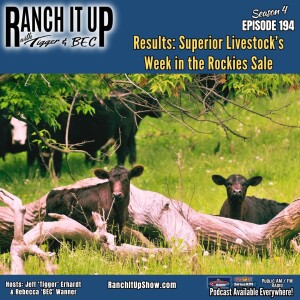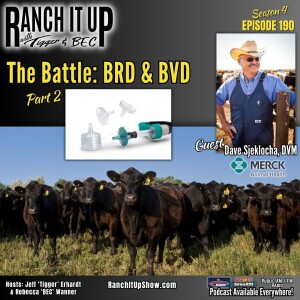We hear about 2 products that many have heard of and are using, MultiMin and Lactipro from Axiota. Plus we have market information, cattle for sale and lots more all wrapped into this all new episode of the Ranch It Up Radio Show. Be sure to subscribe on your favorite podcasting app or on the Ranch It Up Radio Show YouTube Channel.
EPISODE 191 DETAILS
HOW TO USE MULTIMIN & LACTIPRO
Your Best Shot at Strategic Trace Mineral Supplementation for Cattle
Supports Cattle Health and Reproduction
Multimin® 90 is a unique injectable solution containing zinc, copper, manganese, and selenium, proven to support cattle health and reproduction. Research shows that strategic trace mineral supplementation enhances breeding success, healthy calving, and improved immunity.
Successful Breeding
Strategic trace mineral supplementation improves trace mineral status in breeding stock, leading to more calves in fewer days (references 1-2 below).
Healthy Calving
Third-trimester supplementation of trace minerals supports cow-to-calf trace mineral transfer and colostrum quality when used with a scours vaccine.3-4.
Enhanced Immunity
Enhances cattle vaccine protection and immune response when used as part of a vaccination protocol.5-6.
Why Is Trace Mineral Supplementation Necessary?
Inadequate trace mineral status in cattle can lead to suppressed immune function, lower fertility, and decreased growth. Oral nutrition programs face challenges such as:
Antagonists in water/feed binding minerals in the rumen, limiting absorption
Variation in intake among cattle
Increased mineral demand during stressful events, which oral minerals cannot quickly meet
How Does Multimin 90 Work?
Multimin 90 complements an oral nutrition program by increasing zinc, copper, manganese, and selenium levels in cattle. Administered via subcutaneous injection, it reaches peak levels in the blood within 8-10 hours and is stored in the liver for later use.
Benefits of Strategic Supplementation with Multimin 90
Reaches peak plasma levels within 8-10 hours
Bypasses rumen antagonists
Ensures consistent supplementation for every animal injected
Can be used during high-demand periods like calving, breeding, vaccination, and transportation
When to Use Multimin 90
Cows and Heifers
Last trimester of pregnancy
30 days pre-breeding or at CIDR insertion (11 days before AI)
Bulls
Weaning
90 days post-weaning
45-60 days prior to breeding season
Calves (2 months of age or older)
Branding/first vaccination
Weaning/preconditioning
Stockers
At processing
How to Use Multimin 90
Consult your veterinarian and follow label directions.
Multimin 90 has a 14-day pre-slaughter withdrawal and 0-day milk withdrawal.
Calculate the correct dosage based on the animal's weight and age.
Maximum volume per injection site is 7 mL.
Follow Beef Quality Assurance guidelines for proper subcutaneous injections.
By supplementing trace minerals, cattle producers can enhance herd health, reproduction, and immunity, leading to better productivity and success.
References:
Daugherty, S., et al. 2002. Texas A&M University publication. 39-43.
Mundell, L.R., et. al. 2012. Prof. Anim. Sci. 28(1): 82-883.
Hurlbert, J.L., et al. 2024. J. Anim. Sci. (120)1-20
Palomares, R.A., et al. 2021. 102nd Conference of Research Workings in Animal Diseases. Chicago, IL. 433 Pp.
Hoyo-Jaramillo, A. et al. 2022. Res Vet Sci. 152:582-595.
Palomares, R.A., et al. 2016. Veterinary Immunology and Immunopathology. 178(1):88-98.
IMPORTANT SAFETY INFORMATION FOR MULTIMIN® 90: Not for use in humans, keep out of reach of children. Multimin 90 has a pre-slaughter withdrawal time of 14 days after injection. Do not use it during the first trimester of pregnancy or in pre-ruminant calves as safety has not been established. Selenium and copper are toxic if administered in excess and may lead to sudden death, depression, weakness, ataxia, salivation, and drooling. Do not use concurrently with other selenium or copper injections or boluses. Maximum volume per injection site is 7 mL. Allow a minimum of 30 days before considering repeat dosing. See prescribing information.
Introduction to Lactipro
Lactipro is a rumen-native probiotic containing a live, stable strain of Megasphaera elsdenii (Mega e®), an effective lactic acid utilizer. It helps cattle producers maintain healthy rumen pH and improve profitability by accelerating finishing diets and reducing post-terminal processing mortality.
Key Benefits of Lactipro
Shortens step-up period by 50% or more
Reduces post-terminal processing performance losses
Supports rumen health in hospital cattle
Lactipro promotes rumen health during transitions to higher-grain diets, grazing crop residue, and as bulls move to higher energy diets during development.
How Does Lactipro Work?
Naturally occurring Mega e takes weeks to handle grain-based diets effectively. Fast-growing bacteria produce excessive lactic acid, lowering rumen pH and causing health issues like acidosis. Lactipro introduces Mega e directly into the rumen, consuming lactic acid and producing butyric acid, which promotes cell growth and better VFA absorption.
The Importance of Mega e Strain
MS Biotec’s patented Mega e strain is selected for its:
Rapid growth and resilience
Production of butyric acid
Compatibility with feed additives
Enhanced rumen fermentation with other microbials
Two Formulations of Lactipro
LactiproNXT®
An easy-to-use drench available in 200 mL and 1,000 mL pouches, ideal for processing multiple cattle.
LactiproFLX®
A small capsule in a 25-capsule resealable pouch, perfect for individual animals or small groups.
Administration
Both formulations provide equal bacterial counts and are effective, with an extended shelf life requiring refrigeration. LactiproFLX comes in three types:
Dairy – for replacement heifers and mature cows
Feedlot – for feedlot cattle and developing bulls
Calf – for young calves
Use Cases
Accelerated Step-Up
Shortens step-up period by 50% or more for a faster diet transition.
Terminal Processing
Reduces post-terminal processing performance losses.
Other Use Cases
Supports rumen health during diet transitions, grazing, and bull development phases.
Integrating Lactipro ensures a healthier rumen, leading to better overall cattle health and profitability.
UPCOMING SALES & EVENTS
Isa Beefmasters: October 5, 2024, San Angelo, Texas
BULL SALE REPORT & RESULTS
Churchill Cattle Company
Van Newkirk Herefords
Gardiner Angus Ranch
Cow Camp Ranch
Jungels Shorthorn Farms
Ellingson Angus
Edgar Brothers Angus
Schaff Angus Valley
Prairie Hills Gelbvieh
Clear Springs Cattle Company
CK Cattle
Mrnak Hereford Ranch
Frey Angus Ranch
Hoffmann Angus Farms
Topp Herefords
River Creek Farms
Upstream Ranch
Gustin’s Diamond D Gelbvieh
Schiefelbein Farms
Wasem Red Angus
Raven Angus
Krebs Ranch
Yon Family Farms
Chestnut Angus
Eichacker Simmentals & JK Angus
Windy Creek Cattle Company
Pedersen Broken Heart Ranch
Mar Mac Farms
Warner Beef Genetics
Arda Farms & Freeway Angus
Leland Red Angus & Koester Red Angus
Fast - Dohrmann - Strommen
RBM Livestock
Weber Land & Cattle
Sundsbak Farms
Hidden Angus
Wheatland Cattle Company
Miller Angus Farms
L 83 Ranch
U2 Ranch
Vollmer Angus Ranch
A & B Cattle
Carter Angus Farms
Roller Ranch
Montgomery Ranch
Jorgensen Farms
DLCC Ranch
Four Hill Farm North Country Angus Alliance
Spruce Hill Ranch
Wilson Angus
FEATURING
Tina Greiman
Axiota
https://axiota.com/
Merck Animal Health
@MultiMinUSA
Mark VanZee
Livestock Market, Equine Market, Auction Time
https://www.auctiontime.com/
https://www.livestockmarket.com/
https://www.equinemarket.com/
@LivestockMkt
@EquineMkt
@AuctionTime
Kirk Donsbach: Stone X Financial
https://www.stonex.com/
@StoneXGroupInc
Shaye Koester
Casual Cattle Conversation
https://www.casualcattleconversations.com/
@cattleconvos
Questions & Concerns From The Field?
Call or Text your questions, or comments to 707-RANCH20 or 707-726-2420
Or email RanchItUpShow@gmail.com
FOLLOW Facebook/Instagram: @RanchItUpShow
SUBSCRIBE to the Ranch It Up YouTube Channel: @ranchitup
Website: RanchItUpShow.com
https://ranchitupshow.com/
The Ranch It Up Podcast available on ALL podcasting apps.
Rural America is center-stage on this outfit.
AND how is that? Tigger & BEC Live This Western American Lifestyle.
Tigger & BEC represent the Working Ranch world and cattle industry by providing the cowboys, cowgirls, beef cattle producers & successful farmers the knowledge and education needed to bring high-quality beef & meat to your table for dinner.
Learn more about Jeff 'Tigger' Erhardt & Rebecca Wanner aka BEC here: TiggerandBEC.com
https://tiggerandbec.com/
#RanchItUp #StayRanchy #TiggerApproved #tiggerandbec #rodeo #ranching #farming
References
https://www.stonex.com/
https://www.livestockmarket.com/
https://www.equinemarket.com/
https://www.auctiontime.com/
https://gelbvieh.org/
https://www.imogeneingredients.com/
https://alliedgeneticresources.com/
https://westwayfeed.com/
https://medoraboot.com/
http://www.gostockmens.com/
https://www.imiglobal.com/beef
https://www.tsln.com/
https://transova.com/
https://axiota.com/
https://axiota.com/multimin-90-product-label/















